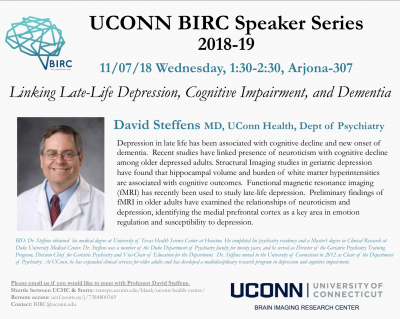Author: webdev
Call for InCHIP-BIRC Seed Grants
UConn’s Institute for Collaboration on Health, Intervention, and Policy (InCHIP) and the UConn Brain Imaging Research Center (BIRC) are co-sponsoring a seed grant funding opportunity for faculty at UConn Storrs, UConn Health, and the regional campuses. This grant is designed to fund an innovative pilot project that will directly support an external grant application in health behavior or health policy with a substantial neuroimaging component. Health is broadly defined and includes physical and mental health and outcomes with critical implications for health. The funded pilot project must involve neuroimaging- related research that includes MRI, TMS, tDCS/tACS, and/or EEG usage at BIRC.
One seed grant of $30,000 is available through this seed grant competition. Funding in the amount of $15,000 (half of the seed grant) will be provided in the form of a limited number of allocated hours on MRI, EEG, and/or TMS equipment at BIRC. The remaining $15,000 may be used to fund other research costs associated with the pilot project.
This funding is intended to enable investigators to demonstrate feasibility, develop scientific and technical expertise, establish collaborations, and, secondarily, publish in peer-reviewed journals.
One of the goals of this funding mechanism is to encourage incorporation of BIRC’s neuroimaging services into the pilot project. Therefore, at least one of the Principle Investigators on the seed grant application must be new to BIRC and not have previously utilized BIRC’s neuroimaging services.
Investigators with experience in neuroimaging methods, as well as those with little or no experience may apply for this grant, but those with limited experience must include a collaborative plan for how they will acquire such experience.
An external grant application should be submitted through InCHIP within one year of completing the pilot project.
Key Dates
- Friday, February 15, 2019 FOA posted
- Monday, April 8, 2019 12-12:45pm optional webinar (email boundaryspanners@chip.uconn.edu to reserve)
- Friday, April 26, 2019 Letters of Intent (required) due by 11:59 PM EST
- Friday, May 3, 2019 Applicants notified of LOI approval decision
- Friday, May 17, 2019 InCHIP Affiliate Application due by 11:59 PM EST
- Friday, May 31, 2019 Full Proposals due by 11:59 PM EST
- June 2019 Applicants notified of award decision
- July 1, 2019 – June 30, 2021 Award period
To Apply
Talk: Dr. James V. Haxby, Dartmouth College
Dartmouth College
Distinguished Speaker
Wednesday, February 20 2019 3:30-5:00PM Bousfield A106
Abstract: Multivariate pattern analysis (MVPA) has revealed that information is encoded in finegrained patterns of cortical activity that can be measured with fMRI. Study of cortical functional connectivity also has revealed fine-grained topographies in the connectome that are closely related to these patterns of activity. The surface structure of functional cortical topographies, however, allows considerable variability across brains for encoding the same information. We introduced a new conceptual framework with computational algorithms that make it possible to model the shared information that is encoded in fine-grained functional topographies that vary across brains. This framework, “hyperalignment”, models shared information as a high-dimensional information space, rather than attempting to model a shared or canonical topographic structure in the physical space of cortical anatomy. Hyperalignment is based on computational algorithms that discover this space and calculate transformations that project individually-variable patterns of neural activity and connectivity into the common model information space.
Research Focus: My current research focuses on the development of computational methods for building models of representational spaces. We assume that distributed population responses encode information. Within a cortical field, a broad range of stimuli or cognitive states can be represented as different patterns of response. We use fMRI to measure these patterns of response and multivariate pattern (MVP) analysis to decode their meaning. We are currently developing methods that make it possible to decode an individual’s brain data using MVP classifiers that are based on other subjects’ data. We use a complex, natural stimulus to sample a broad range of brain representational states as a basis for building high-dimensional models of representational spaces within cortical fields. These models are based on response tuning functions that are common across subjects. Initially, we demonstrated the validity of such a model in ventral temporal cortex. We are working on building similar models in other visual areas and in auditory areas. We also plan to investigate representation of social cognition using this same conceptual framework.
Visitors from UCHC are encouraged to use the UCHC-Storrs shuttle service. Talks can also be joined remotely. Please contact us if you are interested in meeting with the speaker.
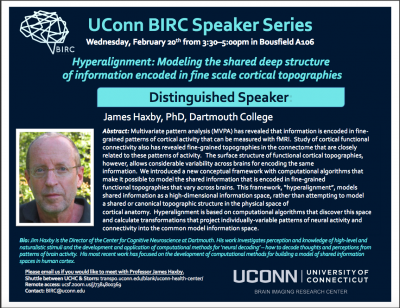
UConn BIRC Trailblazer Award Announced
Issue Date
December 19, 2018
Background
Since the opening of the University of Connecticut (UConn) Brain Imaging Research Center (BIRC) in June 2015, there has been an increase and diversification of user-base, neuroimaging-related extramural grants, and neuroimaging expertise of students and faculty. However, there is still room for greater utilization of BIRC, which presents opportunities for BIRC to offer the resources to perform high-profile and neuroimaging-intensive research that other fully occupied imaging centers cannot offer.
Objective
The BIRC Trailblazer Award was created to allow research teams to perform cutting-edge research and/or perform research that will benefit the BIRC community at-large. The objective of the 2019 BIRC Trailblazer Award is to fund: (1) high-risk high-reward projects with exceptional innovation that lead to raising the visibility of UConn, College of Liberal Arts and Sciences (CLAS) and BIRC; and/or (2) projects that will benefit the BIRC community at-large (e.g. methods development). The project is intended to lead to high-profile peer-review publications, release of a public database, and/or work that is cited and utilized by large-number of UConn researchers in their grants and manuscripts. The project should also lead to large-scale and high-profile extramural grant applications shortly after the end of the funding period.
Talk: Clinical Translation of Resting State Networks
Northeastern University and MIT
Distinguished Speaker
Wednesday, January 30 2019 3:30-5:00PM Bousfield A106
Abstract: Psychiatric neuroimaging has been based primarily on group inferences, but this research has not fundamentally altered patient diagnosis or treatment. The future quality of healthcare in psychiatry will benefit from a timely translation of basic research findings into more effective and efficient patient care. I will describe ways in which the intrinsic functional architecture of the human brain, as elucidated by resting state networks (RSNs), can provide neuro-markers supporting 1) early identification of individuals at risk for mental health difficulties, so that perventive treatment can reduce or even avert future difficulties, 2) neuroprediction, aimed at personalized or precision medicine targeted for selection of an optimal treatment program, and 3) cutting-edge, noninvasive, behavioral interventions such as mindfulness based real-time fMRI neurofeedback, used to augment current available treatments and limit the progression of psychiatric disorders.
Bio: Susan Whitfield-Gabrieli is a Professor of Psychology and Founding Director of the Interdisciplinary Science and Engineering Complex (ISEC) Imaging Center at Northeastern University with affiliation also at the McGovern Institute for Brain Research at MIT. Her primary mission is to understand the brain basis of psychiatric disorders and to promote the translation of this knowledge into clinical practice. Towards this end, she employs multimodal neuroimaging techniques to investigate the pathophysiology of psychiatric and neurodevelopmental disorders such as schizophrenia, depression, bipolar disorder, ADHD, autism, and dyslexia. Her goals are to discover biomarkers for improved diagnosis, early detection (potentiating early intervention and possibly prevention), prediction of the therapeutic response (targeted towards precision medicine), and development of novel therapeutic techniques (e.g., real-time fMRI neurofeedback) with the hope of improving (or augmenting) currently available treatments. A secondary goal of her research is to develop functional imaging analysis tools to share with clinicians and the neuroimaging community at large.
Visitors from UCHC are encouraged to use the UCHC-Storrs shuttle service. Talks can also be joined remotely. Please contact us if you are interested in meeting with the speaker.
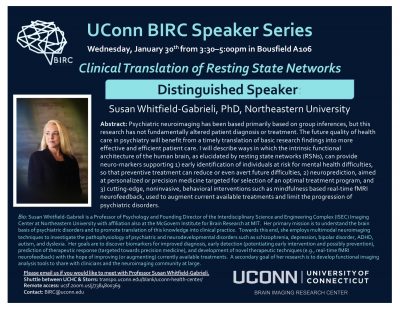
Clinical MRI scans now being offered at BIRC
UConn Health Patients Can Now Get MRIs at UConn in Storrs
UConn Health patients in eastern Connecticut will now be able to get MRI scans done in Storrs just as if they were at UConn Health in Farmington, thanks to a collaboration between doctors and researchers at the two campuses.
UConn’s Brain Imaging Research Center (BIRC) houses a powerful 3 Tesla Magnetic Resonance Imaging (MRI) scanner that was installed in 2015 and originally dedicated purely to research. The BIRC’s machine can take detailed pictures of fine structures in the brain. It can also do functional MRI, which shows subtle changes in blood flow in the brain as a person thinks. Medical details – tiny flecks of blood that might signal a concussion, or small injuries to the spine or extremities – also show up beautifully on the scanner. But the state had not previously licensed the BIRC’s machine to perform medical work. Doctors at UConn Health and researchers at the BIRC thought that should change.
“Soon after I started as chair, it became clear we had a long history of our UConn Husky athletes having scans done on the outside. But then their docs would bring the scans to us for a second read because they trusted us,” says Dr. Leo Wolansky, head of radiology at UConn Health. “It’s our moral obligation to take care of our own people,” but it was a lot of unpaid work too, he observes. Other patients in eastern Connecticut, including students, staff, and faculty, who wanted to use UConn Health doctors but worked and lived near Storrs also found it inconvenient to drive to Farmington for a scan. That meant a lot of UConn money leaving the institution, Wolansky adds, an undesirable phenomenon known as “leakage.”
So he began working with former BIRC scientific directors Inge-Marie Eigsti and Jay Rueckl, and more recently BIRC director Fumiko Hoeft, along with regulatory and business development staff at UConn Health, to get permission from the state to use the center’s machine for medical imaging. Then, with the help of UConn Health MRI technologist Brian Hausner, MRI service manager Elisa Medeiros installed protocols to run clinical scans. The picture archiving communication system team at UConn Health oversaw the setup of the hardware needed to transmit medical data securely from the BIRC, which is located in the Phillips Communication Sciences Building in Storrs, to UConn Health in Farmington.
It took months of work, but on Nov. 7, the BIRC scanned Clinical MRI Patient #1. The term “Clinical MRI Patient #1” had a double meaning. It referred to the first clinical scan chronologically, but it was also a HIPAA-compliant way to refer to the top executive at UConn, President Herbst, who agreed to be the “test case.” She has given permission to publish this information, and wants everyone to know she’s fine.
“The President’s support of the project was critical,” says Wolansky.
UConn Health doctors can now schedule MRIs for their patients at the BIRC in Storrs for Monday and Wednesday afternoons as easily as if they were going to the imaging center in Farmington. Urgent scans can be squeezed in at other times on a case-by-case basis. The BIRC capacity will free up some space at UConn Health, bringing new patients into the system, and is not expected to impact research done at the center at all.
“The biggest benefit is the integration between campuses. It’s a huge success for us to do this,” says Hoeft, the director of BIRC, noting that revenue from the scans will enhance the financial stability of the center.
Wolansky, who is based in Farmington, agrees. UConn’s Farmington and Storrs campuses function largely independently from one another, so this collaboration is based on goodwill, he says.
“They are UConn and we are UConn,” he adds. “Even though [patients] may be 40 minutes away by car, when we read the scans [at the imaging center in Farmington], it’s no different than if the patients were down the hall!”
This story was originally published in UConn Today
Fumiko Hoeft Receives an Award from the Society for Neuroscience
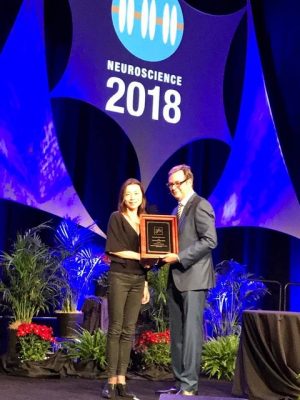
The Society for Neuroscience (SfN) recently awarded BIRC Scientifc Director Fumiko Hoeft the Science Educator Award. This award, supported by The Dana Foundation, “honors an outstanding neuroscientist who has made significant contributions to educating the public about neuroscience.” Congratulations, Dr. Hoeft!
Talk: Functional Networks and Speech Production
Wednesday December 5, 2018 1:30-2:30 PM Arjona 307
Haskins and McGill University
Abstract: A comprehensive understanding of the neural processes for speech production is critical for theory and practice with direct influence on the capability for early identification of typical and atypical development and aging and the development of innovative and optimized treatment regimes. For the most part, the neural processes instantiated in models and theory are incomplete due to an almost exclusive focus on task-induced activation (TIA) and the positive BOLD response (PBR), to the exclusion of task-induced deactivation (TID) and the negative BOLD response (NBR). A related limitation are approaches that fail to fully account for the complex network level interactions that contribute to both sensorimotor and cognitive control for speech. Our recent approach focuses on the identification of functional networks (FN) and the contribution of both activation and deactivation, to gain a comprehensive representation of the neural processes for speech production. The approach is providing insight into brain-behavior relations and in identifying typical and atypical neural organization not easily identified using standard fMRI approaches. The presentation will include recent data on the positive and negative BOLD signal contributions to speech production including an overview of the potential importance of the negative BOLD signal. In addition, neuroimaging data on individuals who stutter will be presented as a model to understand the impact of neurodevelopmental deficits on neural organization.
Bio: Vincent Gracco is currently a Senior Scientist and Vice President of Scientific Operations at Haskins Laboratories. He was a Professor in the School of Communication Sciences and Disorders, McGill University from 1999-2015 and was Director of the Centre for Research on Brain, Language and Music, McGill University from 2008-2015. His research focuses on the neuroscience of human communication using multiple neuroimaging modalities and physiological techniques. Current research areas include the neural control of spoken language, sensorimotor dysfunction associated with stuttering and other speech motor disorders, speech motor learning, bilingualism and the relationship between language and music.
Visitors from UCHC are encouraged to use the UCHC-Storrs shuttle service. Talks can also be joined remotely. Please contact us if you are interested in meeting with the speaker.
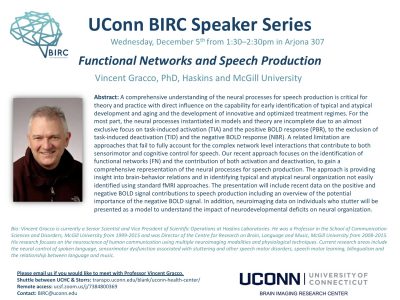
Tour the Brain: BIRC at the International Dyslexia Association 2018 Annual Conference
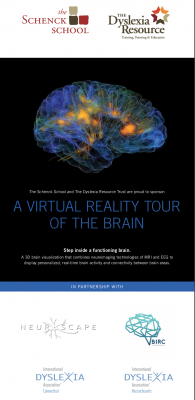
The BIRC is thrilled to announce its first community outreach event. UConn BIRC is partnering with the International Dyslexia Association (IDA) and Neuroscape to host a virtual reality tour of the brain. Join us in making neuroscience fun and accessible to the public!
The VR tours will take place at the IDA Massachusetts and Connecticut booth located in the exhibit hall at Foxwoods Resort and Casino October 24th through 26th.
For additional information, including registration, please visit IDA’s website.
Talk: Linking Late-Life Depression, Cognitive Impairment, and Dementia
David C. Steffens, M.D., M.H.S.
UCONN Health, Department of Psychiatry
Wednesday, November 7 2018 1:30-2:30PM Arjona 307
Abstract: Depression in late life has been associated with cognitive decline and new onset of dementia. Recent studies have linked the presence of neuroticism with cognitive decline among older depressed adults. Structural Imaging studies in geriatric depression have found that hippocampal volume and burden of white matter hyperintensities are associated with cognitive outcomes. Functional magnetic resonance imaging (fMRI) has recently been used to study late-life depression. Preliminary findings of fMRI in older adults have examined the relationships of neuroticism and depression, identifying the medial prefrontal cortex as a key area in emotion regulation and susceptibility to depression.
Speaker Bio: Dr. Steffens has been funded by the NIH for over twenty-five years. His research focuses on links between late-life depression and subsequent cognitive decline and development of dementia. Assessments include structural and functional brain imaging, neuropsychological testing, blood work for peripheral markers and genetics, personality assessment, functional status, and measures of stress and social support.
Visitors from UCHC are encouraged to use the UCHC-Storrs shuttle service. Talks can also be joined remotely. Please contact us if you are interested in meeting with the speaker.
